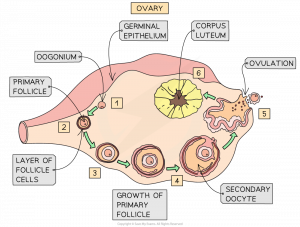What is Oogenesis? Definition, Stages, Process
In the female reproductive system, the formation and production of female gametes are referred to as Oogenesis. As you can guess, it is a very important process in which eggs are produced in various types of living organisms across the ecosystem. Thus, it might be essential for the students who are currently covering the reproductive system chapter in the biology subject. Moreover, to help these people out, we have put together a detailed guide for the process of Oogenesis, and oogenesis stages in the below article.
What is Oogenesis?
As stated in the above section, the process of Oogenesis is a procedure that occurs inside a fetus, where female gametes are produced. Moreover, in this process, multiple stages are involved, which occur before the birth of a female. The primary oocytes that are produced during this process are converted into secondary oocytes, while some of them undergo the process of degeneration.
Besides, the process of Oogenesis is made possible because of a special germ called, oogonium. This germ multiplies in number, by using the mitosis process. And this involves multiple stages, which we are going to explain in much more detail below.
Stages of Oogenesis
The multiple stages involved oogenesis process are,
- Pre Natal
- Antral
- Pre-Ovulatory
- Ovulation
- Fertilization
Pre Natal Stage
The first stage of Oogenesis involves the growth of the primary oocyte that is contained in meiosis-I, and the transformation of follicular cells into granulosa cells, which play a major role in the secretion of glycoproteins, that forms the zona pellucida or protective layer around the primary oocyte.
Antral Stage
The Antrum, which is a region made up of cellular fluids known as secondary follicles, undergoes development twice a month, in the presence of two essential hormones such as the luteinizing hormone, and the follicle-stimulating hormone.
Pre-Ovulatory Stage
Once the meiosis-I process is completed, this stage begins, which starts the production of two unequal haploid cells, that are located in the follicle. Now in the two cells, only one receives the lesser cytoplasm, while the other takes part in ovum formation. Thus the cell with a polar body multiplies into two, while the other arrests the secondary cell in the meiosis-2 phase.
Ovulation
From the above sections, as you can guess, the development of oocytes occurs in the ovaries. Now with the start of the menstrual cycle, the number of follicle cells in the ovaries increases rapidly, and at the same time, the size of the primary oocyte also increases. After this, the follicles attain maturity, which is observed by the conversion of the primary oocyte into a secondary oocyte. Thus, the follicle breaks, and releases the secondary oocyte from the fallopian tube, this process is called ovulation.
Fertilization
The process of meiosis-II ends with fertilization, as a third polar body is generated, instead of oocytes degenerating over some time while being stuck in the meiosis-II cell division. And in fertilization, the process of spermatogenesis also plays a major role.
Conclusion
In the above article, we have provided a comprehensive description of an oogenesis diagram and the 5 stages of oogenesis. If you have any doubts about any other chapters or topics in the subject, then it would be a good idea to join the Online Interactive classes offered by multiple platforms. Besides, the Tutoroot platform is currently offering a budget-friendly online home tuition classes platform program with multiple benefits. If you want to learn more about these benefits, visit the official website.
Explore the informative biology blogs available on the Tutoroot website to enhance your understanding of key concepts. With Tutoroot’s personalised Biology online tuition, you can tailor your learning experience to suit your individual needs and pace. Whether you’re looking for extra practice or a deeper understanding, Tutoroot offers customized lessons designed just for you. Begin your learning journey with a FREE DEMO session, giving you a firsthand look at how one-on-one online guidance can improve your skills. Experience the advantages of having a dedicated tutor by your side, helping you to master Biology more engagingly and effectively.
FAQs
Describe the process of oogenesis?
The process of oogenesis, as stated above, involves the formation or production of female gametes.
What is Fertilization?
Fertilization is defined as the process of combining female and male gamete, to produce a cell called the zygote.


Thanks for sharing. I read many of your blog posts, cool, your blog is very good. https://accounts.binance.com/cs/register?ref=S5H7X3LP